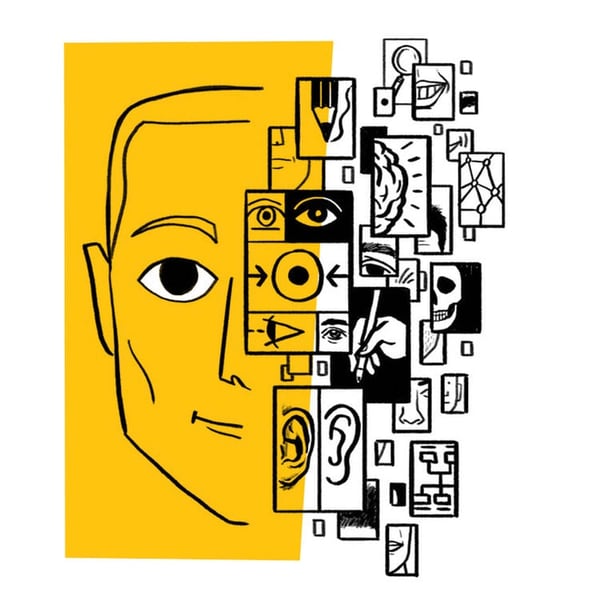Drawing on knowledge
Unlocking visual thinking tools can enrich the creation and dissemination of knowledge.
Have you ever tried to draw a portrait? At the risk of stating the obvious, portraiture is a process of studying your subject, accumulating observations until they add up to something that holds together; something tangible that reflects what you've understood. That’s a pretty useful metaphor for the way we acquire knowledge. We keep hold of the insights we trust, piecing them together as we move gradually towards a better understanding, a fuller picture. There’s no such thing as a perfect portrait, just as there’s no such thing as complete knowledge on any subject. There will always be more to observe, other angles to pursue and different ways to interpret what you see. A drawing is a blend of the facts as we perceive them, our sense of their relative importance and our ability to describe them. Knowledge is similarly shaped by personal perspective.

When we run workshops at Scriberia, drawing a portrait is often the first thing we ask people to do. For us, drawing is much more than just a great metaphor for knowledge, it’s the key to unlocking it, and often the most effective way to share it. The challenge of drawing mirrors the way we strive to make sense of things in other areas; drawing demands focus, attention and analysis and, as such, it can be a catalyst for purposeful engagement in absolutely any subject. Using drawing in this way has nothing to do with creating works of art. It’s a practical discipline – it’s art that works – a life-skill neglected for far too long. And drawing is not the preserve of the unusually gifted or the formally trained, any more than writing is the preserve of great novelists. From a young age, though, many of us turn our backs on drawing as a way of communicating, put off by a sense that we lack the necessary talent. Our ability to capture ideas visually is allowed to die of neglect, without a second thought for the opportunities for discovery and expression that die with it.
But it wasn’t always like this. There was a time when drawing was seen as an indispensable tool for the building and sharing of knowledge. In the Victorian era, society put great stock in drawing as a skill, producing not only artists, but also people able to map, invent, plan, explain, explore, document and design. The nature of work may have changed a little in the intervening years but, at Scriberia, we believe drawing is no less important today. It’s a uniquely powerful tool in helping people to think, work and communicate, regardless of their field of expertise. We perceive the world through a combination of what we can see and what we can assume based on past experience. And, while that’s generally a very useful trait, it’s hard to find fresh insight when your field of view is dominated by what you already know. The act of drawing puts our assumptions on hold and encourages us to really notice things. Whether we’re looking at a person, a landscape, a complex organisation or a microscopic organism, we see more when we clear our view of expectation and inference. As Bertrand Russell, once said, “[f]acts are discovered by observation, not by reasoning.” The drawing itself may be good, bad or indifferent, but the heightened awareness we gain from the process of close observation never fails to expand on what we knew before. Of course, being more observant isn’t enough on its own. We must also learn to articulate what is significant about our observations, and shape them into useful knowledge. With every mark we make, we assert our own interpretation of the facts; we establish the importance of one detail over a myriad of others. Drawing is decision making. How much detail to include is up to the artist.
At Scriberia we always push for simplicity; pictures that capture only what the viewer really needs to know. When they work with us, our clients (experts in areas as diverse as digital finance and diabetes) are expected to let go of the detail and prioritise. Whether the pen is in our hand or theirs, drawing demands that they decide what’s really important. And in asking us to filter out the unnecessary and give shape to the necessary, drawing makes our knowledge more shareable, and more tangible. It turns a nebulous swirl of observations and personal perceptions into a solid piece of communication in a language everyone can understand. Charles Darwin’s functional mapping out of the tree of life, Alexander Graham Bell’s scruffy drawings of the first telephone and countless other examples since prove that even the flimsiest sketch can carry the weight of a world-changing concept. Regardless of your artistic ability, a drawing is likely to connect with its audience more quickly and more memorably than text. The majority of people engage with pictures naturally and eagerly - visual processing is what our brains do best.
We see no reason why drawing shouldn’t be placed at the heart of any discipline. It’s a versatile tool that can be invaluable as we grow, shape and share our knowledge. It can take on many forms, from observational sketches to cartoons, maps to process flow charts, but the first step towards embracing drawing and its many benefits is to forget your artistic insecurities and give it a go. So, why not grab a pencil and try a quick portrait of that person opposite you? I guarantee you’ll discover something you didn’t already know.
This text first appeared in Knowledge Quarter's 2018 collection of essays.
